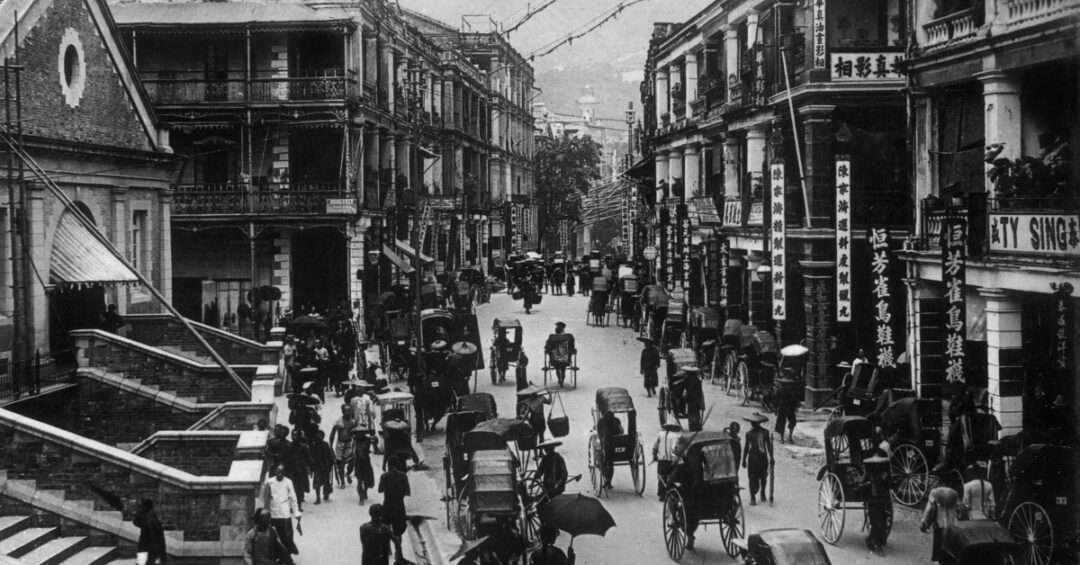Prehistoric period (pre-Qin)
Archaeological research in Hong Kong began in the 1920s. Based on the remains of ancient human activity unearthed at various sites along the coast, the history of Hong Kong can be traced back to more than 6,000 years ago.
Human activity in Hong Kong dates back to the Palaeolithic period, between 39,000 and 35,000 years ago. Several stone tools from this period have been excavated in the Wong Tei Tung area of Sai Kung.
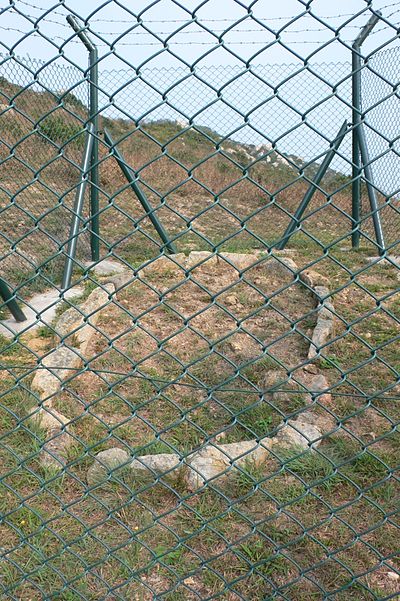
The stone circle of the diversion is one of the remains of the Late Stone Age.
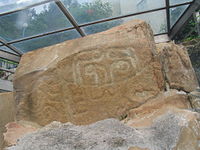
The rock carvings in Cheung Chau are one of the relics of the Bronze Age.
Upper Ancient History (Qin to Yuan)
Hong Kong has been under Chinese administration since Qin Shi Huang, who first unified China.
At the end of the Eastern Jin Dynasty, Lu Zhuan, the leader of a local rebellion, led his men to flee and settle on Lantau Island after being conquered by Liu Yu’s troops. Written records of migration from the mainland date back to the Eastern Jin Dynasty.
In the late Southern Song Dynasty, the two young emperors, Zhao Duanzong and Zhao Bing, were forced by the Yuan army to flee to Hong Kong, where they are said to have rested on a large rock in Kwa Wan, Kowloon.
During the Southern Song Dynasty, Tang Yan Long, a native of Lung Yeuk Tau in Fanling, took part in the imperial examinations and became a scholar.
During the Song and Yuan dynasties, many clans moved from the Middle Kingdom to the mainland and outlying islands of the New Territories.
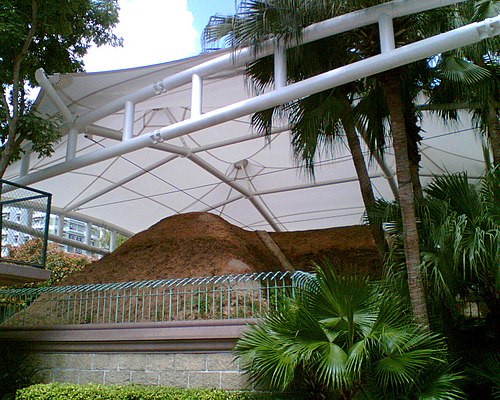
The Lei Cheng Uk Han Tomb in Sham Shui Po, built during the Eastern Han Dynasty, is now a museum.
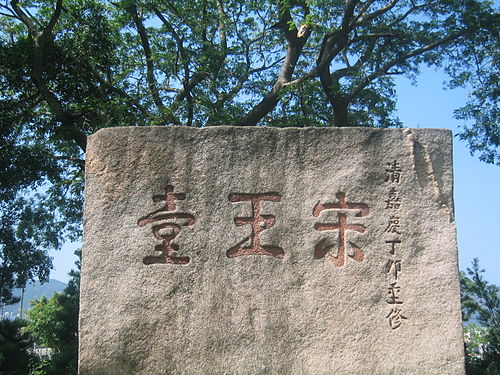
Sung Wong Toi Stone Tablet, the original tablet was destroyed during the Japanese rule in Hong Kong, and the current one was restored in 1960.
Middle Ages (Ming and Qing)
In 1370, the Ming dynasty established the Official Fu Inspection Department, which was roughly equivalent to the present-day Hong Kong area.
In 1521 (the 16th year of Zhengde), the Portuguese forced their way into Hong Kong in an attempt to trade with Guangzhou, and fiercely fought with Ming naval forces near Tuen Mun.
In 1810, Zhang Baozai brought 270 Chinese sailing ships and 1,200 cannons to accept the Qing Dynasty’s offer of peace.
By 1818 (Jiaqing’s 23rd year), the population of Xin’an County reached 239,112 and 366 new villages were added, including 345 Hakka villages.
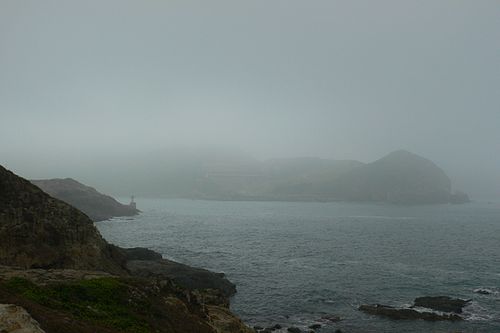
Fotomun in the mist, formerly a key customs post.

Lantau Island was seen by a painter in 1794.
Pre-British Hong Kong (Opening of the port to WWII)
Cession of Hong Kong (1842)
The cession of Hong Kong began in 1842 and the opening of the port began in 1841, when on 20 February 1840, the British government issued four directives appointing Yiru as a full representative to send an expeditionary force against China. The Qing government sent the Governor of Zhili, Qishan, to negotiate with the British army, so Qishan went to Guangzhou as the Minister of Handpicked Affairs and negotiations between the British and the Chinese began.
In the early 1841s, the Qing court negotiated with Britain on several occasions to no avail. In 1841, the Qing dynasty was defeated by the British Empire in the First Opium War and the Treaty of Nanking was signed with Britain the following year, ceding Hong Kong Island and the neighbouring Ap Lei Chau to Britain. Since then, Hong Kong’s population has grown and it has gradually developed into an entrepôt for trading and warehousing.
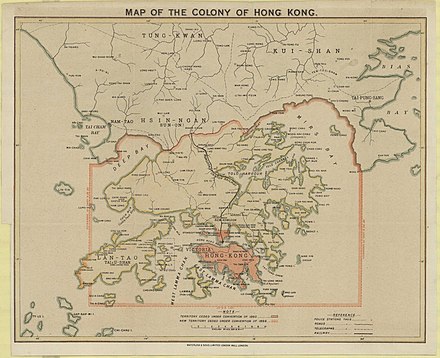
Hong Kong Island (red) was ceded in 1840, the Kowloon Peninsula (red) was ceded in 1860, and the New Territories (red box) was leased in 1898.

The lease of the New Territories was signed by Li Hongzhang in 1898. This picture was taken at the Governor’s Office on 15 January 1900, when Li Hongzhang, who had gone to Guangzhou to take up the post of Governor of Guangdong and Guangxi, passed through Hong Kong on his ship, discussing the Kowloon Walled City with the Governor of Hong Kong, Mr Blake; and when he was recalled to Hong Kong to mediate in the Xinjiao Treaty in July of the same year, the ship passed through Hong Kong again, and Mr Blake kept Li Hongzhang to stay in his post to ensure mutual protection of the Southeast.
The early years of the opening of the port (1841 – 1900)
After officially colonising Hong Kong Island in 1841, Britain declared Hong Kong a free port and continued to confiscate the land of the indigenous inhabitants, known as the ‘opening of Hong Kong’. British merchants, including opium traders, gradually established Hong Kong as a hub for free trade with the East. American opium traders and bankers also travelled to Hong Kong to participate in trade with southern China, namely Guangdong, Fujian and Taiwan.
In June 1842, Purdincha commanded the mobilization of more than 100 ships and 10,000 soldiers from India. On 29 August, Jain and Iribu signed the Treaty of Nanking with Purdincha on behalf of the Qing government on board the British ship HMS Cornwallis on the Nanjing River.
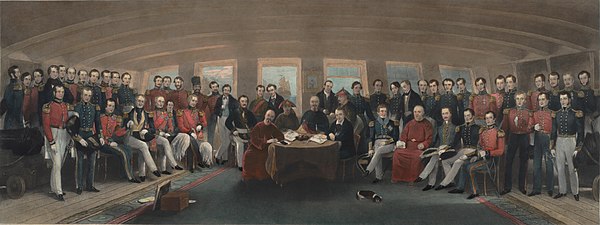
Signature Drawing
In 1843, the Qing government stationed an inspector from the Kowloon Division in Kowloon. In 1846, the Kowloon Walled City was established, with over 100 shops on the Kowloon Peninsula and many temples, such as the Hau Wong Temple in Kowloon City and the Kwun Yum Temple in Mongkok. The Kowloon peninsula is one of the few natural deep-water harbours in the world, with a width of 1.5 to 9.6 kilometres and a depth of 2 to 14.5 metres, allowing huge ships to berth freely.
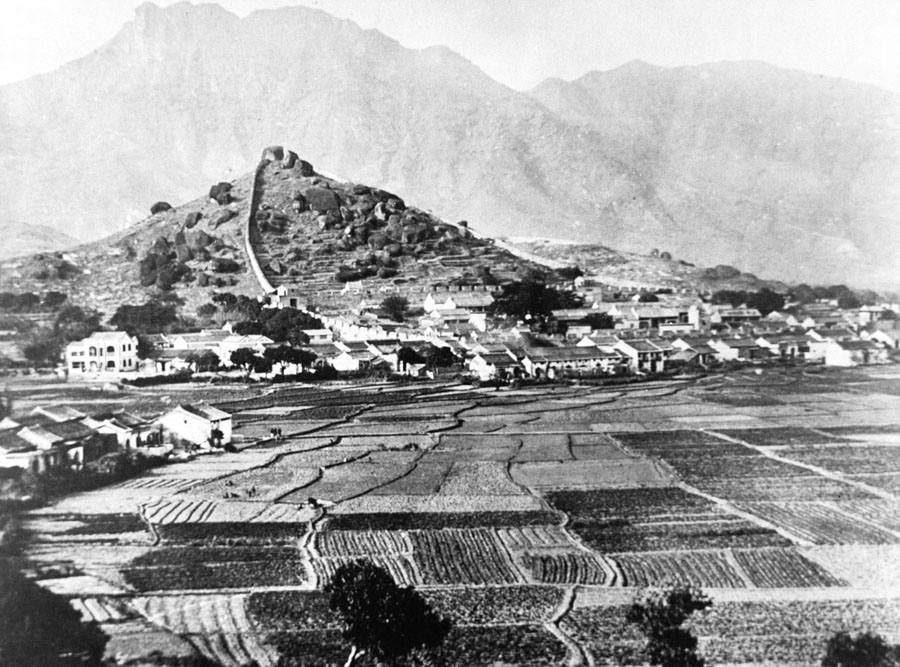
The Kowloon Peninsula in 1843
When the Taiping Rebellion began in 1851, many southern Chinese merchants moved to Hong Kong to escape the war. The population of Hong Kong increased from over 33,000 in 1851 to over 120,000 in 1865. The Qing government initially limited trade to a single port in Guangzhou, but since the opening of the five ports of commerce, Hong Kong has become a major entrepot for the Great Powers and China, with Guangdong and Fujian merchants from Guangzhou and other parts of Guangdong and Fujian moving to Hong Kong.
Southeast Asia was a colony of the world powers and the economy was controlled by the Fujianese, who transhipped goods to the five trading cities via Hong Kong, while the powers, the Manchus and the merchants of the five trading ports collected local business fees and the British and Fujianese made huge profits from the transhipping. Guangzhou was the centre of British enterprise in China, but after the opening of Hong Kong, British companies (mainly opium) were centred in Hong Kong and shipped from Hong Kong to the five trading cities.

Hong Kong in 1851
In 1860, Lieutenant-General Clinton arrived in Hong Kong from Calcutta, India, as the new Commander of the Army, and commanded the British 44th Regiment Task Force to forcefully occupy the Tsim Sha Tsui area on 18 March, before withdrawing from the Kowloon Peninsula on 19 May. On 23 October, Prince Gong Yiqi signed the Treaty of Extension (i.e. the Sino-British Treaty of Beijing) and exchanged the ratification of the Sino-British Treaty of Tianjin.
On the eve of the formal exchange of treaties, Britain proposed to add three articles to the Treaty of Peking, one of which was “the incorporation of the Kowloon Division of Guangdong within the boundaries of British Hong Kong”; the sixth paragraph of the Treaty provided that “…… the Great Emperor of the Qing dynasty hereby determines that the boundaries of this territory shall be paid to the Great Sovereign of Great Britain and to his heirs and shall be incorporated within the boundaries of Hong Kong……”.On this basis, the British occupied part of the territory of the Kowloon Division of San On County, which is now south of Boundary Street on the Kowloon Peninsula (including Stonecutters Island).
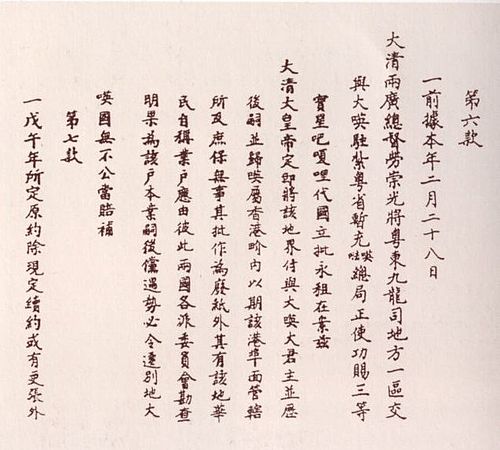
The Beijing Treaty
In 1873, Hong Kong people were mainly fishermen, sailors, farmers, butchers, shopkeepers and labourers.
In the 1890s, plague broke out in southern China, and in the spring of 1894, over 100,000 people were reported dead in Guangzhou. In May of the same year, there was an outbreak of the plague in Sheung Wan, an area with a high concentration of Chinese, with up to 100 deaths per day. As a result, 2,552 people died of the plague that year, some 100,000 Chinese left Hong Kong and trade fell dramatically. The plague continued to occur occasionally in Hong Kong for the next 30 years, with another 1,290 people dying from the plague between 1898 and 1900.
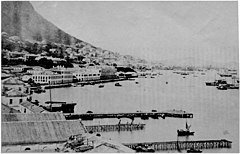
Hong Kong in 1872
After the end of the Sino-Japanese War in 1895, Germany, France and Russia, who had been lobbying for the Qing government, had an excuse to demand land leases; subsequently, the situation was tense and Britain felt that it had to gain control of neighbouring lands if it was to defend Hong Kong.
On 2 April 1898, negotiations for the compulsory lease of the New Territories began. On 24 April, Dou Naylor was instructed by the British Foreign Office to present Li and others with a map of the site, but Li insisted that he would not allow it, and on 19 May Dou Naylor brought with him a draft of the Sino-British Treaty on the Extension of the Boundary of Hong Kong, which was “accompanied by a map” showing the extent of the boundary proposed by the British and agreed by the Chinese. The draft “map” indicated the area proposed by the British side and agreed by the Chinese side, and specified that the boundary would be a “new lease”, i.e. a leasehold for 99 years. Li et al. examined the above and agreed to comment only on the minor details; a comprehensive agreement was reached between the British and Chinese sides on the Treaty on the Extension of the Boundary of Hong Kong.
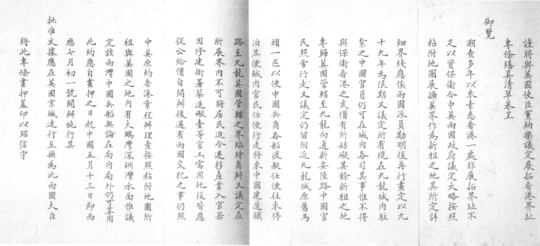
The Convention Between Great Britain and China Respecting an Extension of Hong Kong Territory
On 9 June 1898, the Treaty on the Extension of the Boundary of Hong Kong was signed in Beijing, under which the Qing Government agreed to lease the New Territories north of Boundary Street in Kowloon up to Shenzhen River, together with 235 islands, to the British for a period of 99 years; the British were only targeting the French and the Russians, not the Qing.
The Qing government retained administrative powers over Kowloon Walled City and the right to use Kowloon Walled City Pier “provided that it does not interfere with the defence of Hong Kong”; on 27 December 1899, the British Monarch in Council resolved to revoke this clause and let Britain take over Kowloon Walled City unilaterally. Prior to this, the British had taken over the New Territories in April 1899, with some initial resistance, but this eventually ceased and the city became part of Hong Kong, but was administered separately from the urban areas.

New Territories and New Kowloon leased in the Dedicated Territories
After the signing of the Treaty, some indigenous inhabitants knew that the British had come to confiscate their land again and resisted when the British took over the New Territories, resulting in a fierce Six-Day War in the New Territories. The iron gates at Kam Tin Kat Hing Wai were dismantled by the British and shipped to the United Kingdom as war trophies, which were not returned until the 1920s.
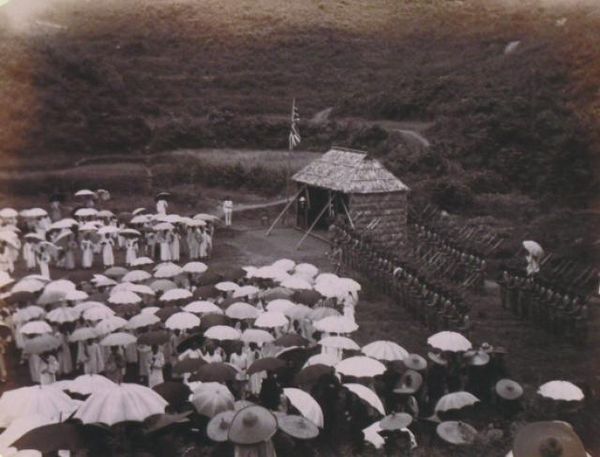
Ceremony held at Tai Po, New Territories, on 16 April 1899 by representatives of the United Kingdom in connection with the taking over of the New Territories
Year 1901-1941
At the beginning of the 20th century, Hong Kong developed as an entrepot for trade with southern China. Hong Kong’s population grew steadily, and so did its urban area, which grew from 140,000 in 1876 to 500,000 in 1914. As the city grew, modern infrastructure was added, such as the Hong Kong Tramway, the Kowloon-Canton Railway, reservoirs, hospitals, the Hong Kong and China Gas, the Chinese Electricity, the Hong Kong Electric Company, the Cable and Wireless, etc. In 1912, the University of Hong Kong was established.
In 1911, the Wuchang Uprising overthrew the Qing Dynasty and proclaimed the establishment of the Republic of China under the name of “Military Government”. 1912 saw the abdication of the Qing Empire and the end of the Qing Dynasty. 1917 saw the declaration of war against Germany, which put Hong Kong in danger of being attacked by German warships during the First World War, but the crisis was eventually resolved. 1922 saw the general strike of Hong Kong seamen and 1925-1926 saw the general strike of the provincial government.
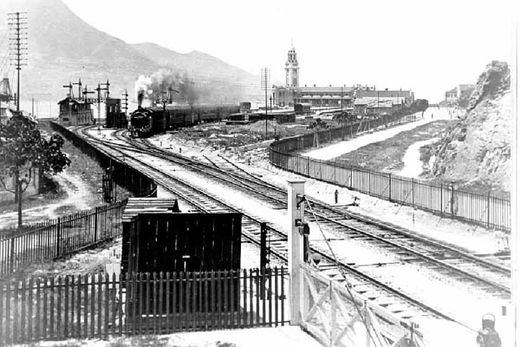
Tsim Sha Tsui Station of the Kowloon-Canton Railway in the 1920s
In 1932, when the Great Japanese Empire formed Manchukuo, the geopolitical situation in East Asia became unbalanced and the British army considered strengthening the defence of Hong Kong. The Great Depression and the impact of the silver standard on the Hong Kong economy, and the outbreak of the War of Resistance against Japan in 1937 not only brought the influx of refugees into Hong Kong, but also brought the threat of the Japanese army one step closer.
In January 1936, Chow Sik Nin was elected unopposed to the first elected seat in the Hong Kong Urban Council after the reorganisation of the Cleansing Board into the Urban Council, the first time in Hong Kong’s history that an elected member was elected to the Council, and the first election in which there was a contender for a seat was the 1940 Hong Kong Urban Council election in which Law Lee Kee was elected.
Prior to 1941, the Chinese Department of Home Affairs maintained contact with the public mainly through the Tung Wah Group of Hospitals and the Po Leung Kuk, as well as various community groups such as clansmen’s associations and clansmen’s associations, and also liaised closely with the Chinese unofficial members of the Executive and Legislative Councils, who were all leaders of the Chinese community in Hong Kong.
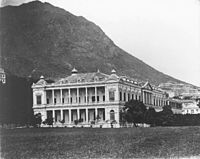
Hong Kong Cleaning Authority
Japanese Occupation (WWII)
At 19:00 on 25 December 1941, the Governor of Hong Kong, Yang Muqi, and Major General Mok Tse-pick surrendered unconditionally to the Japanese at the Peninsula Hotel. At 21:45 Tokyo declared the Japanese occupation of Hong Kong and the Japanese occupation of Hong Kong began.
On 16 September 1945, Rear Admiral Harcourt of the British Navy accepted the unconditional surrender of the Japanese army in Hong Kong on behalf of the British Government and Chiang Kai-shek, Supreme Commander of the Chinese theatre of war and Chairman of the Military Affairs Commission of the Nationalist Government, at the Government House in Hong Kong.
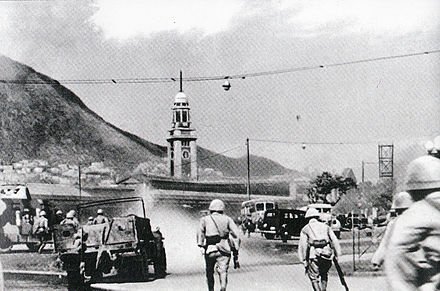
In the morning of 12 December 1941, the Japanese army invaded Tsim Sha Tsui, with the Tsim Sha Tsui Clock Tower in the foreground.
Post-British Hong Kong period (post-war to handover)
In 1952, after the outbreak of the Korean War, the Western countries imposed an embargo on China and dealt a blow to Hong Kong’s re-export trade. Hong Kong gradually developed from an entrepot into an industrial city and its economy grew rapidly.
On 7 February 1985, the House of Commons of the British Parliament debated and passed the Hong Kong Bill on third reading, providing for the end of British sovereignty and rule over Hong Kong with effect from 1 July 1997.
From midnight on 30 June to the early hours of 1 July 1997, the handover ceremony was held in the City Hall on the 5th floor of the new wing of the Hong Kong Convention and Exhibition Centre, in the presence of Chinese President Jiang Zemin, Chinese Premier Li Peng, British Crown Prince Charles, British Prime Minister Tony Blair and over 4,000 other guests.
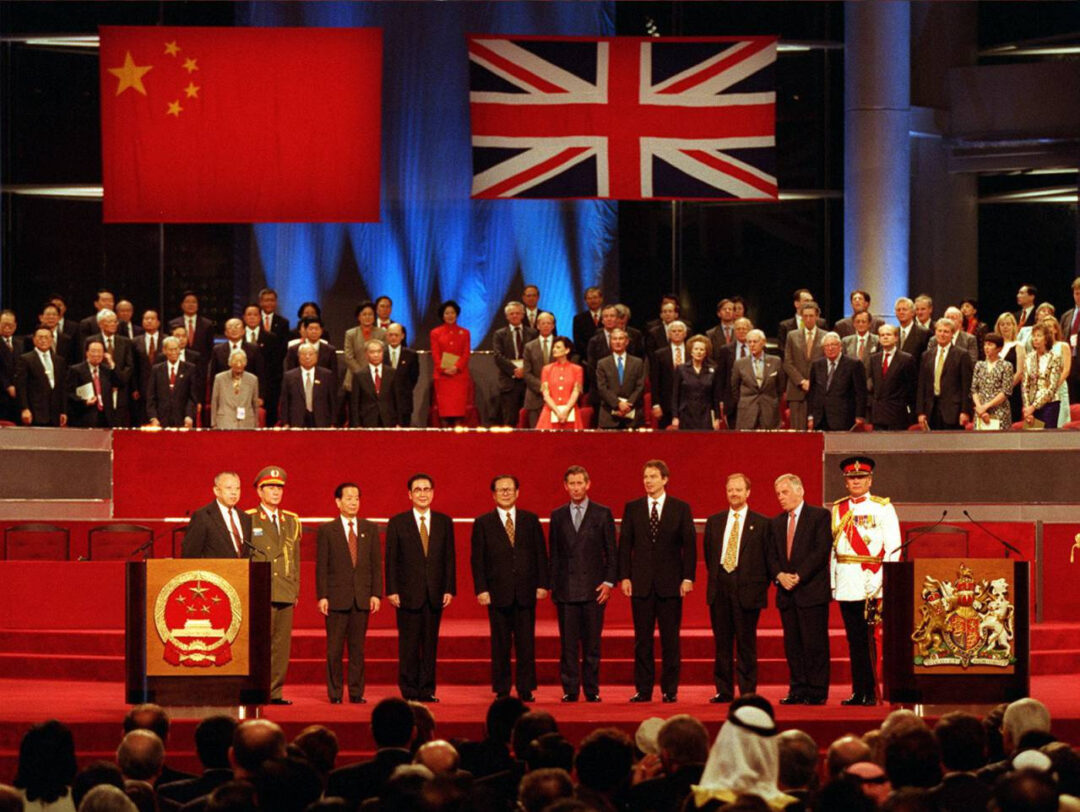
Handover ceremony for Hong Kong on 1 July 1997
(Above images are from Google Images. )
